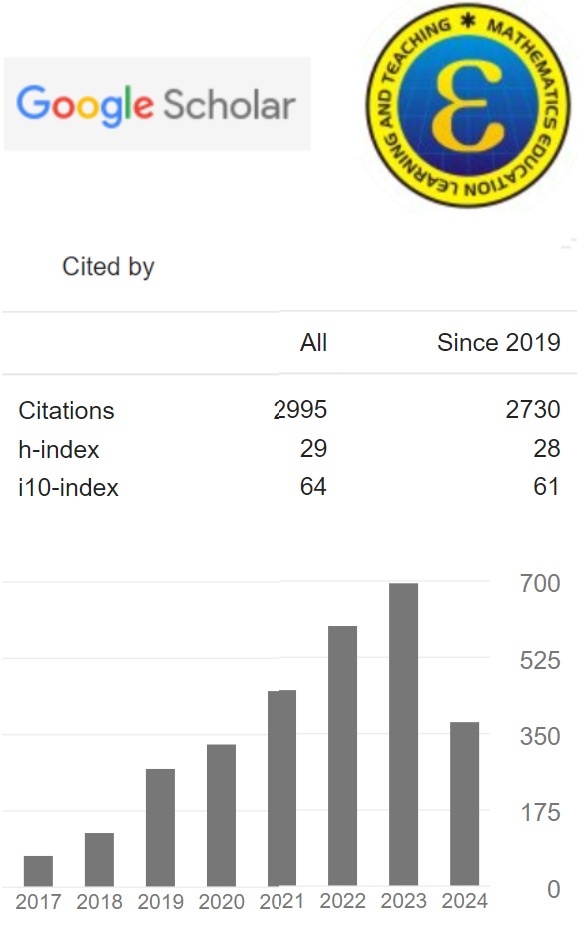Examples and Non-examples as a Road to Understanding the Concept of Function
(1) IAIN Kediri
(2) STKIP PGRI Lumajang
(*) Corresponding Author
Abstract
This qualitative study aims to describe the conceptual understanding of prospective mathematics teachers at STKIP PGRI Lumajang by determining examples and non-examples of functions. This research was conducted by giving tests and interviews with 12 subjects. Data were analyzed using Miles & Huberman model. Â This study showed that the subjects investigated whether paired to determine a given statement is a function or not. Subjects focus on specific expressions, e.g., or others that they have previously recognized as a function. However, some subjects used the vertical line test to determine a given graph represents a function or not, although they were unable to explain why the vertical line test was the appropriate method. Their understanding is limited to procedural knowledge such as mental representations and incomplete concept images, then failing to be comprehensively linked to the definition of the concept of function
ÂKeywords
Full Text:
PDFReferences
Bardini, Caroline, Pierce, R., & Vincent, J. (2013). First year university students’ understanding of functions: Over a decade after the introduction of CAS in Australian high schools, what is new. Proceedings of the 9th DELTA Conference on Teaching and Learning of Undergraduate Mathematics and Statistics, 2–11.
Bardini, Caroline, Pierce, R., Vincent, J., & King, D. (2014). Undergraduate Mathematics Students’ Understanding of the Concept of Function. Indonesian Mathematical Society Journal on Mathematics Education, 5(2), 85–107.
Carlson, M., Jacobs, S., Coe, E., Larsen, S., & Hsu, E. (2002). Applying covariational reasoning while modeling dynamic events: A framework and a study. Journal for Research in Mathematics Education, 352–378.
Cohen, L., Manion, L., & Morrison, K. (2007). Research methods in education. London: Routledge.
Creswell, J. W. (2015). Educational research: Planning, conducting, and evaluating quantitative and qualitative research, enhanced pearson eText with loose-leaf version–access card package. Pearson Education, Inc.
Creswell, J. W., & Creswell, J. D. (2017). Research design: Qualitative, quantitative, and mixed methods approaches. Sage publications.
Ekayanti, A. (2018). Generalisasi teorema aproksimasi weierstrass. FIBONACCI: Jurnal Pendidikan Matematika Dan Matematika, 4(2), 105–112.
Forehand, M. (2005). Bloom’s taxonomy: Original and revised. emerging perspectives on learning, teaching, and technology.
Fujita, T., & Jones, K. (2006). Primary trainee teachers’ understanding of basic geometrical figures in Scotland.
Gagatsis, A., Elia, I., Panaoura, A., Gravvani, K., & Spyrou, P. (2006). An empirical four-dimensional model for the understanding of function. International Group for the Psychology of Mathematics Education, 137.
Ghazali, N. H. C., & Zakaria, E. (2011). Students’ procedural and conceptual understanding of mathematics. Australian Journal of Basic and Applied Sciences, 5(7), 684–691.
Güçler, B., & Heather, T.-M. (2015). A Discursive Approach to Support Teachers’ Development of Student Thinking About Functions. Proceedings of the 18th Annual Conference on Research in Undergraduate Mathematics Education, 562–567.
Hagen, C. (2015). Undergraduate Students’ Understandings of Functions and Key Calculus Concepts. Proceedings of the 18th Annual Conference on Research in Undergraduate Mathematics Education. 574-580
Hejnỳ, M., Jirotková, D., & KratochvÃlová, J. (2006). Early conceptual thinking. International Group for the Psychology of Mathematics Education, 289.
Hitt, F. (1998). Difficulties in the articulation of different representations linked to the concept of function. The Journal of Mathematical Behavior, 17(1), 123–134.
Kidron, I., & Picard, T. D. (2006). Concept definition, concept image and the discrete–continuous interplay. International Group for the Psychology of Mathematics Education, 441.
Larue, R., & Engelke, N. (2015). The Influence of Function and Variable on Students’ Understanding of Calculus Optimization Problems. Proceedings of the 18th Annual Conference on Research in Undergraduate Mathematics Education, 673–677.
Long, C. (2005). Maths concepts in teaching: Procedural and conceptual knowledge. Pythagoras, 2005(62), 59–65.
NCTM (2000). Principles and standards for school mathematics (Vol. 1). Virginia: Key Curriculum Press.
Miles, M. B., Huberman, A. M., Huberman, M. A., & Huberman, M. (1994). Qualitative data analysis: An expanded sourcebook. sage.
Noto, M. S., Pramuditya, S. A., & Handayani, V. D. (2020). Exploration of Learning Obstacle Based on Mathematical Understanding of Algebra in Junior High School. Eduma : Mathematics Education Learning and Teaching, 9(1), 14. https://doi.org/10.24235/eduma.v9i1.5946
Oehrtman, M., Carlson, M., & Thompson, P. W. (2008). Foundational reasoning abilities that promote coherence in students’ function understanding. Making the Connection: Research and Teaching in Undergraduate Mathematics Education, 27, 42.
Oldham, E., Viseu, F., Martinho, M. H., Doggen, R., Price, E., & Leite, L. (2020). Investigating prospective science and mathematics teachers’ meanings for and representations of functions: An international study. http://repositorium.sdum.uminho.pt/
Panaoura, A., Michael-Chrysanthou, P., Gagatsis, A., Elia, I., & Philippou, A. (2017). A structural model related to the understanding of the concept of function: Definition and problem solving. International Journal of Science and Mathematics Education, 15(4), 723–740.
Radiusman, R. (2020). Studi Literasi: Pemahaman Konsep Anak Pada Pembelajaran Matematika. FIBONACCI: Jurnal Pendidikan Matematika dan Matematika, 6(1), 1–8. https://doi.org/10.24853/fbc.6.1.1-8
Ribeiro, A. J., & da Ponte, J. P. (2019). Professional learning opportunities in a practice-based teacher education programme about the concept of function. Acta Scientiae, 21(2), 49–74.
Roh, K. H. (2008). Students’ images and their understanding of definitions of the limit of a sequence. Educational Studies in Mathematics, 69(3), 217–233.
Vinner, S. (1983). Concept definition, concept image and the notion of function. International Journal of Mathematical Education in Science and Technology, 14(3), 293–305.
Vinner, S., & Dreyfus, T. (1989). Images and definitions for the concept of function. Journal for Research in Mathematics Education, 356–366.
Zazkis, R., & Leikin, R. (2008). Exemplifying definitions: A case of a square. Educational Studies in Mathematics, 69(2), 131–148.
DOI: 10.24235/eduma.v9i2.7368
Article Metrics
Abstract view : 41 timesPDF - 13 times
Refbacks
- There are currently no refbacks.
Copyright (c) 2020
Statcounter


.png)










